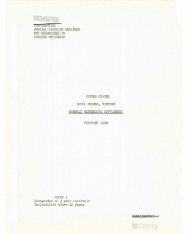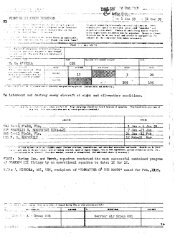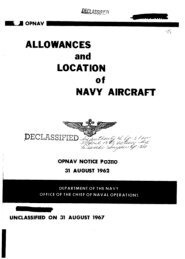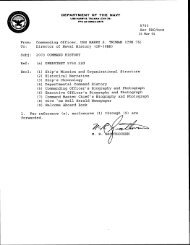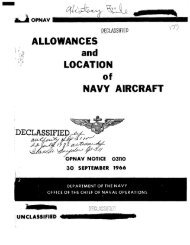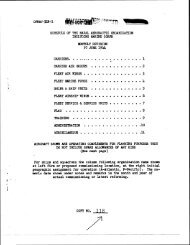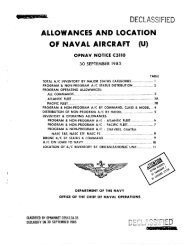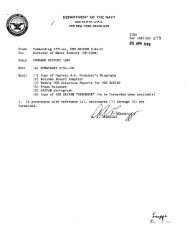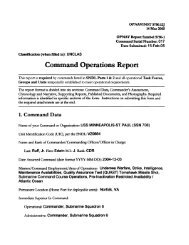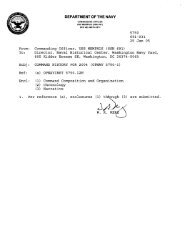VP-9 - Naval History and Heritage Command - U.S. Navy
VP-9 - Naval History and Heritage Command - U.S. Navy
VP-9 - Naval History and Heritage Command - U.S. Navy
Create successful ePaper yourself
Turn your PDF publications into a flip-book with our unique Google optimized e-Paper software.
CHAPTER 3 91<br />
Third <strong>VP</strong>-16<br />
Lineage<br />
Established as Reserve Patrol Squadron NINE HUN-<br />
DRED SIX (<strong>VP</strong>-906) in May 1946.<br />
Redesignated Medium Seaplane Squadron FIFTY SIX<br />
(<strong>VP</strong>-ML-56) on 15 November 1946.<br />
Redesignated Patrol Squadron SEVEN HUNDRED<br />
FORTY ONE (<strong>VP</strong>-741) in February 1950.<br />
Redesignated Patrol Squadron SIXTEEN (<strong>VP</strong>-16) on<br />
4 February 1953, the third squadron to be assigned the<br />
<strong>VP</strong>-16 designation.<br />
Squadron Insignia <strong>and</strong> Nickname<br />
The first insignia used by the squadron was approved<br />
by CNO on 15 October 1951 when it was still<br />
<strong>VP</strong>-741. The design featured a Disney-like alligator<br />
wearing a sailor’s hat with a spy glass in its left h<strong>and</strong><br />
<strong>and</strong> in its right a bomb poised ready to throw at a<br />
periscope projecting from the<br />
water. Colors: background,<br />
white; water, light blue;<br />
periscope, telescope <strong>and</strong><br />
bomb, black; upper body of<br />
alligator, dark green; alligator<br />
chest, light green; tongue <strong>and</strong><br />
bomb tip, red. The nickname<br />
“Fighting Gators,” was highlighted<br />
in red above the top<br />
of the design, <strong>and</strong> the designation<br />
Patrol Squadron 741,<br />
across the bottom.<br />
The squadron’s<br />
first insignia was<br />
a cartoon designed<br />
alligator.<br />
The squadron’s second insignia<br />
featured an eagle<br />
probing for a submarine.<br />
The second insignia used by the squadron superseded<br />
the previous design after its approval by CNO<br />
on 30 October 1953. The insignia portrays an eagle<br />
perched on a fish bowl probing for a small, fish-like<br />
submarine. The heraldic significance of the American<br />
Eagle probing for the submarine in its confined space<br />
of operation portrays the antisubmarine warfare mission<br />
of the squadron. Colors: background, red; body<br />
<strong>and</strong> wings of eagle, black; head, white; beak <strong>and</strong> feet,<br />
orange; water in fish bowl, blue; submarine, black.<br />
The nickname “Eagles,” is highlighted in white against<br />
a black background over the top of the design <strong>and</strong><br />
Patrol Squadron Sixteen across the bottom.<br />
Nickname: Fighting Gators, 1951–1953.<br />
Eagles, 1961–1968.<br />
War Eagles, 1983–present.<br />
Chronology of Significant Events<br />
May 1946: <strong>VP</strong>-906 was established as a reserve<br />
squadron, home-ported at NAS Jacksonville, Fla.,<br />
under operational control of FAW-11 <strong>and</strong> administratively<br />
under <strong>Naval</strong> Air Reserve Training Comm<strong>and</strong>.<br />
The squadron was one of 21 reserve patrol squadrons<br />
established after the war to accommodate the large<br />
number of aircrews recently released from active duty,<br />
utilize the enormous stocks of aircraft in the inventory<br />
<strong>and</strong> serve as an experienced manpower pool in the<br />
event new Cold War tensions erupted into a shooting<br />
war. <strong>VP</strong>-906 flew the Lockheed PV-2 Harpoon <strong>and</strong> the<br />
amphibious PBY-5A/6A Catalina.<br />
15 Nov 1946: <strong>VP</strong>-906 was redesignated <strong>VP</strong>-ML-56<br />
while at Cecil Field, Fla. Under the new designation<br />
system, reserve squadron number designations began<br />
with the number 51 <strong>and</strong> regular <strong>Navy</strong> squadrons<br />
began with 1. All reserve patrol squadrons were designated<br />
as ML. The ML designation used by the reserves<br />
stood for either Medium Patrol Squadrons flying the<br />
twin-engine PV-2 Harpoon or Medium Seaplane<br />
Squadrons flying the amphibious PBY-5A Catalina.<br />
Regular <strong>Navy</strong> patrol squadrons flying the PV-2 were<br />
designated ML also, but those flying the PBY-5A were<br />
designated AM for Amphibian.<br />
Feb 1950: <strong>VP</strong>-ML-56 was redesignated <strong>VP</strong>-741 during<br />
the reorganization of <strong>Naval</strong> Aviation reserve units,<br />
effective the first quarter of 1950. In this period of extensive<br />
defense spending reductions the number of<br />
<strong>Naval</strong> Aviation reserve patrol squadrons was reduced<br />
from a 1949 total of 24 to only 9.<br />
1 Mar 1951: <strong>VP</strong>-741 was recalled to active duty by<br />
the president, the last of the nine reserve patrol<br />
squadrons recalled for service during the Korean War<br />
period. Of the Atlantic fleet squadrons, only one regular<br />
<strong>Navy</strong> squadron, <strong>VP</strong>-7, saw limited combat while<br />
stationed at Iwakuni, Japan, in the last month of the<br />
war.<br />
4 Feb 1953: After the Korean War the decision was<br />
made to augment all of the nine reserve patrol<br />
squadrons activated during the 1950 to 1951 time period<br />
as part of the regular <strong>Navy</strong>. <strong>VP</strong>-741 was redesig-



